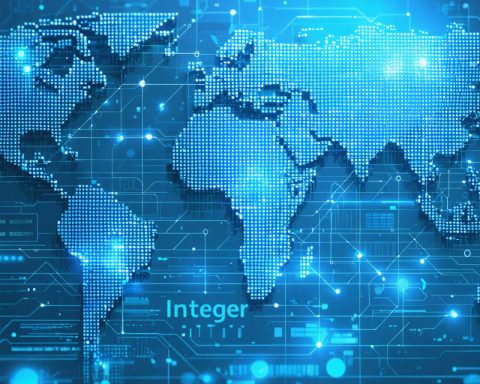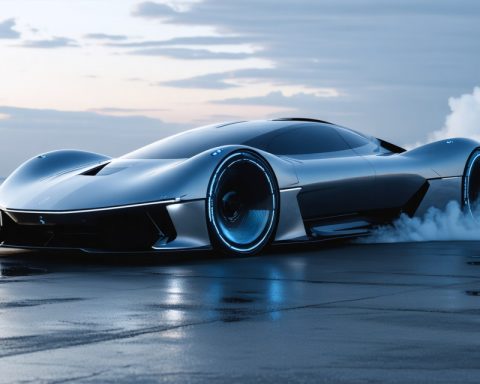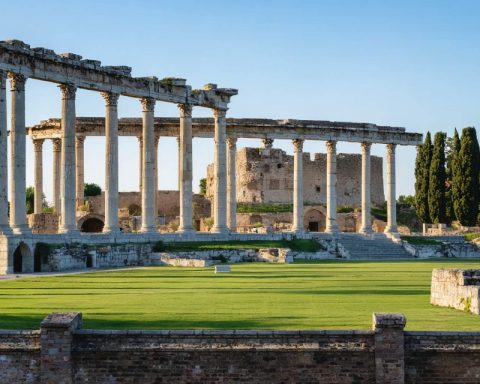- Tesla faces a significant challenge with a recall of over 375,000 vehicles due to steering issues, leading to a 4% drop in its shares.
- The market is experiencing a wider sell-off, with the Dow Jones down nearly 700 points and the Nasdaq dropping over 1.6%.
- Consumer sentiment has declined by 10% according to the University of Michigan, with inflation expectations reaching levels not seen since 1995.
- Robust consumer spending, a key component of GDP, is now on uncertain ground due to waning confidence.
- Analysts are divided on Tesla’s future; some predict growth through new launches, while others are wary of potential dips in China and European markets.
- Investors face a storm of market uncertainty, emphasizing the need for vigilance amid fluctuations in consumer confidence and corporate challenges.
Tesla’s market journey has hit a bump in the road. A significant recall has rocked the electric vehicle giant, sending its shares skidding 4% lower. This comes amidst a broader market sell-off, with the Dow Jones sinking nearly 700 points like a ship in stormy seas, and the Nasdaq dipping more than 1.6%.
Investors’ worries magnify as consumer confidence wavers. The University of Michigan’s latest reading paints a bleak picture—consumer sentiment has dropped 10%, hitting levels not seen in decades. With inflation expectations soaring to heights reminiscent of 1995, the market’s optimism finds itself under siege. The towering hopes pinned on robust consumer spending, a key pillar supporting more than two-thirds of GDP, now seem precariously perched.
Tesla’s recall casts an additional shadow. Over 375,000 vehicles, clouded by steering issues, are called back into the fold—not due to any known mishaps, but as a proactive measure. Thankfully, a software update promises a swift resolution, but the incident underscores vulnerabilities that richly valued stocks like Tesla face amid market uncertainty.
Analysts clash over Tesla’s future. Bulls foresee new horizons with upcoming launches, while bears warn of storm clouds brewing over China and European sales. The 120 times forward earnings valuation tethered to Tesla weighs heavily on the minds of cautious investors.
In these tumultuous times, the market narrative is unequivocal: cracks in consumer confidence and corporate hiccups demand attention. For those navigating the choppy waters of the stock market, the call to vigilance rings loud and clear.
Is Tesla’s Stock Drop a Warning Sign or a Buying Opportunity?
How-To Steps & Life Hacks: Safeguarding Investments Amid Volatility
1. Diversify Your Portfolio: Avoid over-reliance on a single stock or sector, like Tesla, which can expose you to significant risk. Consider investing across different industries and asset classes.
2. Stay Informed: Keep up with market news and updates from credible financial sources. This will help you make informed decisions and recognize when to buy or sell.
3. Think Long-Term: Market fluctuations are normal. If you believe in the long-term potential of a company like Tesla, stay the course and avoid panic selling during downturns.
4. Set Stop-Loss Orders: Protect your investments by setting automatic sell orders if a stock drops to a certain price, helping to minimize losses.
Real-World Use Cases: Tesla’s Product Ecosystem
Tesla’s vehicles are known for their innovation, but the company’s reach extends into other arenas:
– Renewable Energy: Tesla’s solar panels and energy storage solutions, like the Powerwall, allow consumers to harness renewable energy effectively.
– Autonomous Driving: Tesla continuously develops its Full Self-Driving (FSD) software, aiming to revolutionize personal and shared transportation.
Market Forecasts & Industry Trends
Despite the recent setback, the electric vehicle market is projected to grow significantly. According to Allied Market Research, the global electric vehicle market is expected to reach $802.81 billion by 2027, growing at a CAGR of 22.6% from 2020. This growth is driven by increasing consumer awareness and government incentives for clean energy vehicles.
Reviews & Comparisons: Tesla vs. Competitors
– Tesla vs. Rivian: While Tesla focuses on a wide range of models, Rivian has carved a niche in electric trucks and SUVs.
– Tesla vs. Lucid Motors: Lucid targets the luxury electric vehicle market with its Lucid Air sedan, challenging Tesla’s Model S with longer range and premium features.
Controversies & Limitations
– Recall Implications: The recent recall highlights potential quality control and production scale challenges for Tesla, especially as it rapidly expands.
– Autopilot Concerns: Despite advancements, Tesla’s Autopilot feature has faced scrutiny regarding safety, emphasizing the need for regulatory compliance and improvements.
Features, Specs & Pricing: Tesla’s Lineup
– Tesla Model S: Known for luxury, speed, and a range of up to 405 miles.
– Tesla Model 3: Budget-friendly option with a focus on efficiency.
– Tesla Cybertruck: Upcoming, innovative design with competitive towing capacity.
Security & Sustainability
Tesla’s commitment to sustainability is evident in its mission to accelerate the transition to sustainable energy. By producing electric vehicles and expanding solar and storage capabilities, Tesla is leading the charge towards a greener future.
Insights & Predictions
Analysts predict that as Tesla continues to innovate and expand, its market challenges will be counterbalanced by its potential for scaling production and entering new markets. The demand for electric vehicles is anticipated to outstrip supply, benefiting major manufacturers like Tesla.
Pros & Cons Overview
Pros:
– Market Leader in Electric Vehicles
– Continuous Technological Innovation
– Expanding Global Presence
Cons:
– High Valuation Risks
– Regulatory and Recall Implications
Actionable Recommendations
– Evaluate your risk tolerance before investing in high-volatility stocks like Tesla.
– Capitalize on market dips by purchasing stocks at lower prices if you trust their long-term growth.
– Monitor industry trends to stay ahead, including developments in renewable energy and autonomous driving.
For more information, check out the official website of Tesla.
In conclusion, while Tesla faces hurdles, its potential for future success remains robust. Understanding market trends, staying vigilant, and maintaining a diversified investment portfolio are key strategies as investors navigate uncertain waters.








